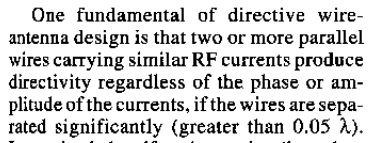Hi Edgar, LF,
both Hartmut and Jean-Pierre are using K9AY
receive antennas with a cardioid pattern pointing northwest, and
their captures of transatlantic LF stations from America have
been superior to anyone else in mainland Europe by a long shot (probably 10
dB in SNR). I think this is mostly due to the fact that they can suppress QRN
from the southeast and Mediterranean sea, which is the dominant
lightning area and QRN source during our winters.
Several times I have attempted to improve my
reception by adding a signal from the garden loop pair to that of the
E-field antenna. Using an indoor goniometer (made of two orthogonal
coils around the outside of a ferrite ring), I was able to make a virtually
rotatable loop, which could produce a good null to south-easterly
QRN and QRM (eg. HGA22). During noisy nights, the
improvement from the QRN reduction was quite significant. However
unfortunately this didn't not hold under quiet conditions. Compared to the
vertical, the noise floor from my loops is about 10 dB higher due
to coupling to adjacent underground ADSL and power lines. This means that
adding in the magnetic contribution often makes things worse rather than
better.
As Richard VK7RO has pointed out, the advantage of
directivity may not be quite the same for your location in Tasmania:
If thunderstorms are over the Tasman sea / New Zealand, a cardioid
antenna pointing towards Europe should have a large benefit. If QRN is
coming from the side (Australian East coast), a classic magnetic loop may be
better. And if the noise direction is coinciding with the
signal (Northwest), there's little you can improve using
antenna directivity.
If I understand you right, you're
saying that in Orford the resonated magnetic loop is not as good as the
vertical probe, and the resistively loaded cardioid is even worse? I'd like to
understand why that is so. Could it be that three is also noise
predominantly magnetic from the vicinity (eg. power supplies, telephone or
power lines)? You might want to try a comparison measurement of
daytime noise floor, with the other end of the EWE shorted (ie closed loop,
acting solely as magnetic antenna) versus open (top wire acting as electric
antenna).
In my understanding, the flag, EWE and K9AY
antennas are all working on the same basic principle, ie superposition of an
omnidirectional pattern from a vertical electric antenna, and a
figure-eight pattern from a loop with a positive and a negative lobe. This
is indeed exactly identical to the operation of a properly terminated
directional coupler, using simultneous capacitive and inductive coupling to a
TEM line. In that sense, the top wire of an EWE is not simply a feeder to
the remote vertical leg, but both an electrical topload and integral part of the
magnetic loop.
On the other hand, you can think about a closed
magnetic loop as two separate pairs of conductors, one vertical pair spaced
horizontally, and one horizontal pair spaced vertically. Witrhin each pair
there are opposed currents, acting as a gradiometer for electric
fields. The vertical legs produce vertically polarized groundwave
radiation, with the desired sine (figure-eight) pattern in the horizontal
plane. The horizontal wires radiate predominantly upwards,
which usually does not contribute to DX reception in a useful manner.
So yes, you could do away with the horizontal conductor, leaving only two
verticals with antiphase currents - very much the same way that an
Adcock pair was used to minimize "night-effect" direction-finding errors from
steep skywave. The only disadvantage would be that the antiphase monopoles
have a large capacitive impedance, which limits the achievable radiation
efficiency to an order of magnitude below that of a same-size closed
loop. But given sufficient size and spacing between the vertical elements, and
the possibility to use a low-noise preamp, this will matter little in a
receive application.
So we have seen that a loop can be replaced
by two electric monopoles driven in antiphase. Obwiously we can also
(and even at the same time) drive them in phase, letting them act
essentially as a (relatively efficient) single omnidirectional vertical. To
then produce a cardioid, the omni- and gradiometer- farfield components will
have to be made equally strong. This implies that the antiphase
vertical currents (eg. 1 A, -1 A) would have to be larger and in
quadrature to the inphase currents (+0.1j A, +0.1j A). In other words,
the two vertical currents have to be almost but not exactly in antiphase.
This picture naturally connects to the "quasioptical" view of
a short two-element Yagi, where the back lobe cancellation is caused
by 180deg+phi phase from the driven currents, augmented by - phi
from the propagation delay difference.
Best 73,
Markus (DF6NM)
Sent: Friday, April 18, 2014 3:27 AM
Subject: EWE antenna
Hi Markus,
On
reading the article on EWE antennas I do not think the loop at Orford is
suitable for 2200 m reception in the EWE configuration!

For 80 m the wire separations is 0.05 * 80 = 4 m.
For 160
m the wire separation is 0.05 * 160 = 8m
For 2200 m the wire separation is
0.05 * 2200 m = 110 m!
This loop is 16m.
From tests conducted at
Orford the reception at frequencies above about 500 kHz are good.
However
less than that frequency there are poor.
I think I will have to
take a different approach.
Regards, Edgar

